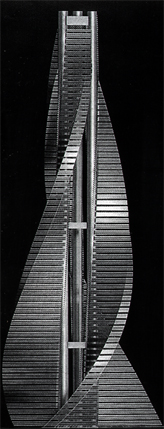Helicoidal Skyscraper facts for kids
Quick facts for kids Helicoidal Skyscraper |
|
|---|---|

The New York Crescent Project
|
|
| General information | |
| Status | Never built |
| Location | New York City |
| Height | |
| Antenna spire | 565 m (1,854 ft) |
| Design and construction | |
| Architect | Manfredi Nicoletti |
| Structural engineer | Sergio Musmeci |
The Helicoidal Skyscraper was a super tall building planned for New York City. It was designed to be about 565 meters (1,854 feet) high. This building was meant to be a business center in Manhattan.
The project was created by Italian architect Manfredi Nicoletti. He worked on it between 1968 and 1974. The building was never actually built. Its special spiral shape was designed to be very good against wind. It also used ideas from wired bridges to make it strong but not too heavy.
Contents
Building Design: How It Works
The design of the Helicoidal Skyscraper was studied by Italian engineer Sergio Musmeci. The building's structure was inspired by the body of a mammal. It aimed to greatly reduce how much wind pushed on it. It also wanted to be strong without being too bulky.
Think of a mammal's limb, like an arm or leg. It has a strong bone in the middle and muscles on the outside that pull. The skyscraper used a similar idea.
The Core and Outer Structure
The center of the building was a strong core made of steel and cement. This core was like the "bone." It had three connected cylinder shapes inside. These cylinders would hold all the elevators and stairs.
Attached to this central core were many steel wires. These wires would pull on the outer parts of the building. The outer parts were like "muscles." They had crisscross structures where the floors would be. These outer parts would push back towards the core. This design made the whole building very stable.
Why the Spiral Shape?
The skyscraper had a unique spiral shape, like a helix. This shape was made by the floors overlapping and twisting around the central core. This twisting movement followed a pattern called the golden spiral.
This special shape helped the building deal with wind. No matter which way the wind blew, the building would react to it smoothly. This design solved two big problems that normal skyscrapers have:
- Most tall buildings are shaped like rectangles. Wind pushes much harder on the long side than the short side. This creates uneven pressure.
- Cylindrical buildings can cause a "Von Karman effect." This makes the wind swirl in a way that creates strong side-to-side forces.
The spiral shape of the Helicoidal Skyscraper would split the wind's force into different directions. This meant the wind would not push the building sideways as much. It would also create a small upward lift. This lift would actually help reduce the weight on the building's foundations.
The project took ideas from two areas not usually linked to tall buildings. One was the twisting shape of a ship's sail, which helps it move through wind. The other was the structure of a cable bridge, which saves a lot of material by using cables to support the main structure.
A Green Building Idea
The Helicoidal Skyscraper can be seen as an example of sustainable or green architecture. This means it was designed to be good for the environment.
Saving Materials and Energy
One way it was sustainable was by using fewer materials. Because of its smart design, it needed less material to be built. This also helps save energy during construction.
Cleaning the Air
Its unique spiral shape was also designed to help with air pollution. The building would react to the wind by creating an upward force. This force would help pull air pollution up and away from the streets below.
Many tall buildings can block air movement. This can trap pollution near the ground. The Helicoidal Skyscraper was designed to avoid this. It was expected to create a "chimney effect." This means warm air would rise along its surfaces, creating air currents. These currents would help move pollution away from the city streets.
Strong and Efficient
The building's design also avoided needing too much extra strength. This saved money. Its circular design meant it could handle wind equally well from any direction. This meant it didn't have weak spots that would need extra strong support.

